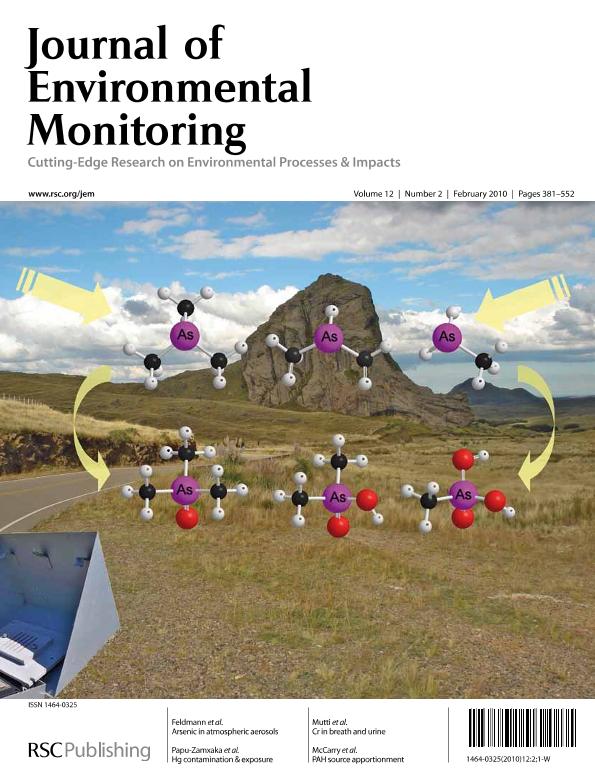Mostrar el registro sencillo del ítem
dc.contributor.author
Jakob, Ronit
dc.contributor.author
Roth, Anja
dc.contributor.author
Haas, Karsten
dc.contributor.author
Krupp, Eva M.
dc.contributor.author
Raab, Andrea
dc.contributor.author
Smichowski, Patricia Nora

dc.contributor.author
Gomez, Dario Gustavo

dc.contributor.author
Feldmann, Jörg
dc.date.available
2020-03-18T20:33:08Z
dc.date.issued
2010-02
dc.identifier.citation
Jakob, Ronit; Roth, Anja; Haas, Karsten; Krupp, Eva M.; Raab, Andrea; et al.; Atmospheric stability of arsines and the determination of their oxidative; Royal Society of Chemistry; Journal Of Environmental Monitoring; 12; 2; 2-2010; 409-416
dc.identifier.issn
1464-0325
dc.identifier.uri
http://hdl.handle.net/11336/100120
dc.description.abstract
Biovolatilisation of arsenic as their arsines in the form of AsH 3, and mono-, di and trimethylarsine has often been determined under laboratory conditions. Although environmental point sources such as landfill sites or hot springs have been characterised, only limited knowledge is available on how widespread the formation of volatile methylated arsenic compounds are in the environment. Here we studied the atmospheric stability of the different arsines and quantified their oxidation products in atmospheric particulate matter (PM10) in two locations in Argentina. The atmospheric half-life of the arsines range from 19 weeks for AsH3 to 2 d for trimethylarsine (TMAs) at 20 °C in the dark, while during simulated daytime conditions the stability is reduced for all arsines and in particular for the methylated arsines by three orders of magnitude which suggests that TMAs can only be dispersed at night. At both locations the arsenic concentration was in all samples below 1 ng As m-3, which is considered as rural background for arsenic. The oxidation products, i.e. methylarsonate (MA), dimethylarsinate (DMA) and trimethylarsine oxide (TMAO) were identified by using HPLC-ICP-MS/ES-MS in more than 90% of the 49 PM10 samples taken from 8 sampling points at the two geographically different locations. TMAO was the predominate organoarsenicals in both locations (66 and 69%, respectively) while DMA was determined to be between 13 and 19% of all organoarsenicals at the two locations. The concentration of the organoarsenicals ranged from 4 to 60 pg As as TMAO m-3, while the maximum concentration for DMA and MA were 16 and 6 pg As m-3, respectively. No difference in terms of the concentration or distribution of the organoarsenicals in the PM10 samples was identified as significant. Since the two locations were different in climate and industrial impact and sampled in different seasons, these data suggest that methylated arsenicals do occur as background chemicals in the environment. Due to the low atmospheric stability of the methylated arsines, it is suggested that biovolatilization of arsenic as methylated arsines is a widespread phenomenon. More studies however are necessary to identify the major sources and determine the flux of the volatilization process in order to determine whether or not the process has environmental significance.
dc.format
application/pdf
dc.language.iso
eng
dc.publisher
Royal Society of Chemistry

dc.rights
info:eu-repo/semantics/openAccess
dc.rights.uri
https://creativecommons.org/licenses/by-nc-sa/2.5/ar/
dc.subject
ARSENIC
dc.subject
ATMOSPHERIC AEROSOLS
dc.subject
BIOVOLATILIZATION
dc.subject
SPECIATION
dc.subject.classification
Química Analítica

dc.subject.classification
Ciencias Químicas

dc.subject.classification
CIENCIAS NATURALES Y EXACTAS

dc.title
Atmospheric stability of arsines and the determination of their oxidative
dc.type
info:eu-repo/semantics/article
dc.type
info:ar-repo/semantics/artículo
dc.type
info:eu-repo/semantics/publishedVersion
dc.date.updated
2020-03-04T17:32:05Z
dc.journal.volume
12
dc.journal.number
2
dc.journal.pagination
409-416
dc.journal.pais
Reino Unido

dc.journal.ciudad
Cambridge
dc.description.fil
Fil: Jakob, Ronit. University of Aberdeen; Reino Unido
dc.description.fil
Fil: Roth, Anja. University of Aberdeen; Reino Unido
dc.description.fil
Fil: Haas, Karsten. University of Aberdeen; Reino Unido
dc.description.fil
Fil: Krupp, Eva M.. University of Aberdeen; Reino Unido
dc.description.fil
Fil: Raab, Andrea. University of Aberdeen; Reino Unido
dc.description.fil
Fil: Smichowski, Patricia Nora. Comisión Nacional de Energía Atómica; Argentina. Consejo Nacional de Investigaciones Científicas y Técnicas; Argentina
dc.description.fil
Fil: Gomez, Dario Gustavo. Comisión Nacional de Energía Atómica; Argentina. Consejo Nacional de Investigaciones Científicas y Técnicas; Argentina
dc.description.fil
Fil: Feldmann, Jörg. University of Aberdeen; Reino Unido
dc.journal.title
Journal Of Environmental Monitoring

dc.relation.alternativeid
info:eu-repo/semantics/altIdentifier/doi/http://dx.doi.org/10.1039/b915867g
dc.relation.alternativeid
info:eu-repo/semantics/altIdentifier/url/https://pubs.rsc.org/en/content/articlelanding/2010/EM/B915867G
Archivos asociados
